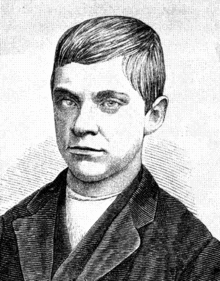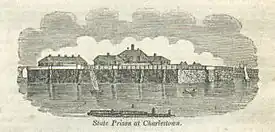Jesse Pomeroy | |
|---|---|
 Drawing of Pomeroy, c. 1870–1880 | |
| Born | November 29, 1859 |
| Died | September 29, 1932 (aged 72) |
| Other names | The Boston Boy Fiend The Boy Torturer The Demon The Red Devil |
| Criminal status | Deceased |
| Conviction(s) | First degree murder |
| Criminal penalty | Death, commuted to life to be served in solitary confinement in 1876, commuted to life imprisonment in 1917 |
| Details | |
| Victims | 2 confirmed, suspected to be 9+ |
Span of crimes | 1871–1874 |
| Country | United States |
| State(s) | Massachusetts |
Date apprehended | April 24, 1874 |
Jesse Harding Pomeroy (/ˈpɒmərɔɪ/; November 29, 1859 – September 29, 1932) was a convicted American murderer and the youngest person in the history of the Commonwealth of Massachusetts to be convicted of murder in the first degree. He was found guilty by a jury trial held in the Supreme Judicial Court of Suffolk County in December 1874. He was also a suspected serial killer.
Background
Jesse Harding Pomeroy was born in Charlestown, Massachusetts, to Thomas J. Pomeroy and Ruth Ann Snowman. He was the second of two children.
Early attacks
On 21 February 1872, a seven year old named Tracy Hayden of Chelsea is beaten and left on Powder Horn Hill. Later, on May 20, an eight-year-old boy, Robert Maier, is also beaten and left in an abandoned outhouse in Chelsea.[1]
About a month after the beating of Robert Maier, on 22 July, another child by the name of Johnny Balch is discovered. He was tied up and beaten in another abandoned outhouse, this one being located on Powder Horn Hill.[1]
Soon after the third attack, the Boston Globe reported that "the public are considerably excited" about what they described as a "Fiendish Boy" who was violently attacking younger children.[1]
Around August 2, 1872, Ruth Ann Pomeroy and her children move away from their home in Chelsea to Broadway Street in the South Boston area. It is mentioned that Thomas Pomeroy had abandoned his family at this point.[1]
A fourth attack against a young child occurs August 17, 1872. George Pratt, seven years old, is found beaten in the area of South Boston by local fishermen. Barely a month later on September 11, another seven-year-old boy, Joseph Kennedy, is assaulted. He is supposedly lured away to a vacant boathouse near the South Boston salt marshes; once there, he's beaten and cut with a pocketknife.[1]
Six days later, on 17 September, railway workers walking along the Hartford and Erie line in South Boston stumble upon Robert Gould, a five-year-old boy, who had been tied to a telegraph post near the tracks, beaten and slashed by a knife.[1]
While walking the streets of Boston, Jesse Pomeroy finds himself near South Boston's Police Station Six and decides to stride up to the window of the building and look inside.[1] Joseph Kennedy, the child who had been assaulted on September 11, was inside the station and once he spotted Pomeroy looking through the window, pointed him out as his assailant to the officers.[1]
Pomeroy was swiftly arrested, brought inside the station and readily admitted to being the "boy torturer".[1] Eventually, the rest of the children who had been assaulted throughout the year all identified Jesse Pomeroy as their attacker.[1]
On September 21, 1872, Jesse Pomeroy is arraigned and heard in front of the Juvenile Court judge Judge William G. Forsaith.[1] The 13 year old Pomeroy confesses to the attacks, is found guilty and sentenced to 6 years at the State Reform School for Boys in Westborough, Massachusetts.[1]
Crimes

In February 1874, at the age of 14, Pomeroy was paroled back to his mother and brother in South Boston. His mother ran her own dressmaking shop, and his brother Charles sold newspapers.
In March 1874, a ten-year-old girl from South Boston named Katie Curran went missing. On April 22, 1874, the mutilated body of four-year-old Horace Millen was found on the marsh of Dorchester Bay. Immediately, the police detectives sought out Pomeroy, despite lacking evidence implicating him in the crime. The body of Katie Curran was found later, in the basement of Pomeroy's mother's dress shop. Her remains were hastily and carelessly concealed in an ash heap.
Trial
Pomeroy was taken to view Millen's body and asked if he committed the murder. At the coroner's inquest, Pomeroy was denied the right to counsel.
The case of Commonwealth v. Pomeroy was heard in the Massachusetts Supreme Judicial Court (Suffolk County, Boston) on December 9 and December 10, 1874. At the trial, the Attorney General argued for a verdict of guilty of murder in the first degree. In his closing arguments, he urged an alternative charge of murder with extreme atrocity, which, according to Massachusetts law, is first-degree murder, but differs from the original charge in the requirement of premeditation.
Pomeroy was pronounced guilty on December 10, 1874, with the jury's recommendation of mercy on account of the prisoner's youth.
Pomeroy's attorney, Charles Robinson, filed two exceptions which were overruled in February 1875, at which point Pomeroy was sentenced to death by hanging.
After the trial

It remained for the Governor to sign the death warrant and assign a date for Pomeroy's execution. However, Governor William Gaston refused to comply with this executive responsibility. The only legal means of sparing Pomeroy's life was through the Massachusetts Governor's Council, and only if a simple majority of the nine-member Council voted to commute the death penalty. Over the next year and a half, the Council voted three times: the first two votes upheld Pomeroy's execution, and both times Governor Gaston refused to sign the death warrant.[2]
In August 1876, the Council took a third vote, anonymously, and Pomeroy's sentence was commuted to life in prison in solitary confinement. On the evening of September 7, 1876, Pomeroy was transferred from the Suffolk County Jail to the State Prison at Charlestown, and began his life in solitary. He was 16 years and 9 months old.[2] Pomeroy remained incarcerated at the Charlestown State Prison.[3]
In prison, Pomeroy claimed that he taught himself to read several foreign languages, including Hebrew; and one visiting psychiatrist found that he had learned German with "considerable accuracy". He wrote poetry and argued with prison officials over his right to have it published, and he studied law books and spent decades composing legal challenges to his conviction and requests for a pardon. A psychiatric report on Pomeroy made in 1914, and quoted extensively in The Boston Globe after his death, noted that Pomeroy had made 10 or 12 "determined attempts" to escape and that handmade tools were frequently found in his possession.[4]
A prison warden reported finding rope, steel pens, and a drill that Pomeroy had concealed in his cell or on his person. According to The Globe, Pomeroy lost an eye after attempting to destroy the side of his cell by redirecting a gas pipe. The 1914 psychiatric report claimed that Pomeroy had shown the "greatest ingenuity and a persistence which is unprecedented in the history of the prison."[4]
In 1917, with the support of District Attorney Joseph Pelletier,[5] Pomeroy's sentence was commuted to the extent of allowing him the privileges afforded to other life prisoners. At first he resisted, wanting nothing less than a pardon. He eventually adjusted to his changed circumstances and appeared in a minstrel show at the prison. In 1929, by this time an elderly man in frail health, he was transferred to Bridgewater Hospital for the Criminally Insane,[3] where he died on September 29, 1932.[6]
In popular culture
- Jesse Pomeroy appears in the novel The Alienist by Caleb Carr, and was subsequently featured in the TNT television adaptation, played by Stephen Louis Grush.
- Fiend: The Shocking True Story of America's Youngest Serial Killer by Harold Schechter.
- The Wilderness of Ruin: A Tale of Madness, Fire, and the Hunt for America's Youngest Serial Killer by Roseanne Montillo.
- My Favorite Murder episode 116 - Robot Grandma is partially about Jesse Pomeroy.
See also
References
- 1 2 3 4 5 6 7 8 9 10 11 12 "Jesse Harding Pomeroy Materials". omeka.net. Boston City Archives. Retrieved 28 November 2023.
- 1 2 "Pomeroy Going to State Farm". The Boston Globe. 1 August 1929. p. 1.
- 1 2 Gribben, Mark. "Jesse Harding Pomeroy." Crime Library. 17. Resurrection. Retrieved on November 27, 2010.
- 1 2 Lyons, Louis (2 October 1932). "Records Show Jesse Pomeroy Never Did Deserve Sympathy". The Boston Globe. p. A57.
- ↑ "Dist Atty Pelletier Pleads for Pomeroy". The Boston Globe. January 2, 1917. p. 1. Retrieved February 20, 2019.
- ↑ "Notorious Life Prisoner Dies in Massachusetts". Appleton Post Crescent. Associated Press. 1932-09-30. p. 2. Retrieved 2018-03-11.
External links
- Court TV's Crime Library: Mark Gribben, "All about Jesse Pomeroy"
- Kobek.com Presents "The Autobiography of Jesse Harding Pomeroy, Written By Himself (1875)" (Archive)
- Kobek.com Presents "Selections From the Writings of Jesse Harding Pomeroy, Life Prisoner Since 1876 (1920)" (Archive)
- Jesse Harding Pomeroy: The teenaged killer
- Works by Jesse Pomeroy at LibriVox (public domain audiobooks)
